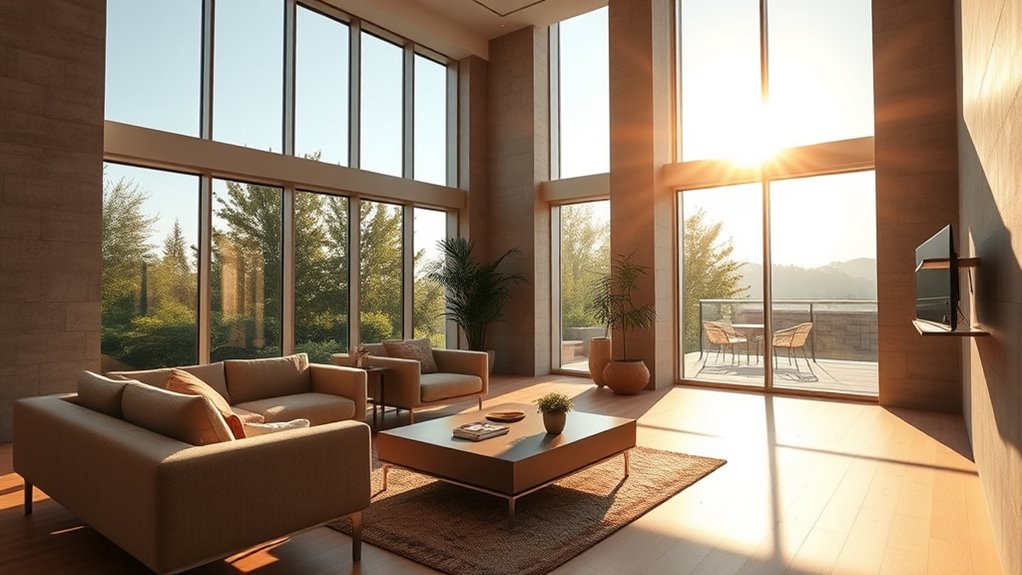Circadian lighting designs your space to support your body’s natural rhythms using strategies like mimicking natural sunlight patterns and adjusting color temperature throughout the day. Bright, bluish-white light in the morning boosts alertness, while warm tones in the evening help signal your body to wind down. By creating dynamic lighting that follows natural light cycles, you can improve sleep quality and mood. Keep exploring to discover how you can optimize your environment for better health.
Key Takeaways
- Incorporate dynamic lighting systems that adjust color temperature and brightness throughout the day to mimic natural sunlight patterns.
- Use high color temperature lighting in the morning to boost alertness and warm, lower temperatures in the evening to promote relaxation and sleep.
- Design indoor spaces with access to natural light whenever possible to reinforce natural circadian cues.
- Integrate daylight simulation technology to replicate outdoor light cycles indoors, supporting healthy biological rhythms.
- Prioritize lighting that supports melatonin regulation, enhancing sleep quality and overall well-being.

Have you ever wondered how light affects your body’s internal clock? It’s fascinating how the quality and timing of light exposure can influence your sleep, mood, and overall health. When designing spaces with circadian lighting, understanding concepts like color temperature and daylight simulation becomes essential. These elements help mimic natural light patterns, guiding your internal rhythms seamlessly through the day.
Color temperature plays a crucial role in creating lighting that supports your circadian rhythm. During the morning and daytime, you want light with a higher color temperature—think bright, bluish-white hues—that closely resemble natural sunlight. This type of light signals your body to stay alert and active, suppressing the production of melatonin, the sleep hormone. As the day progresses and evening approaches, the ideal lighting shifts to warmer tones, with lower color temperatures that resemble sunset or twilight. This shift signals your body to prepare for rest, promoting melatonin production and helping you wind down naturally.
Higher color temperatures in daylight boost alertness, while warmer tones in the evening promote relaxation and prepare your body for sleep.
Daylight simulation is another essential aspect of circadian lighting. It involves designing artificial lighting systems that replicate the natural progression of sunlight throughout the day. By integrating advanced technology, you can create a dynamic lighting environment that adjusts throughout the day, providing brighter, cooler light in the morning and gradually shifting to softer, warmer tones in the evening. This simulation not only enhances your well-being but also reduces the disruption caused by artificial lighting that remains constant or doesn’t change with the time of day.
When you incorporate daylight simulation into your space, you’re fundamentally tricking your body into experiencing natural light patterns, even if you’re indoors. This process helps regulate your circadian rhythm, making it easier to wake up, stay alert during the day, and fall asleep at night. It’s especially beneficial in environments with limited access to natural sunlight, such as offices, hospitals, or homes during winter months. Properly designed circadian lighting, emphasizing appropriate color temperature and daylight simulation, can improve mood, boost productivity, and enhance sleep quality.
Frequently Asked Questions
How Does Circadian Lighting Impact Sleep Quality?
Your sleep quality improves when your environment supports your sleep cycle. Exposure to natural light or circadian lighting boosts melatonin production in the evening, helping you fall asleep faster and stay asleep longer. During the day, bright light keeps you alert, while at night, dim lighting signals your body to prepare for sleep. Proper circadian lighting aligns your internal clock, ensuring better rest and overall health.
Can Circadian Lighting Reduce Energy Costs?
You can reduce energy costs by using circadian lighting, as it promotes lighting efficiency and minimizes unnecessary energy use. By adjusting light intensity and color temperature to match natural rhythms, you’ll use less electricity during the day and evening. This adaptive lighting not only saves money but also supports your well-being. Embracing circadian lighting helps you optimize energy savings while creating a more comfortable and health-promoting environment.
What Are the Best Colors for Circadian Lighting?
You should choose colors with a high color temperature, around 5000-6500K, for circadian lighting to mimic natural daylight. This helps regulate your body’s rhythms and boosts alertness. Opt for lights with excellent color rendering (CRI of 80 or higher) to make sure colors appear natural and vibrant, enhancing your environment. These choices support your circadian system, keeping you energized during the day and relaxed at night.
How Does Age Affect Circadian Lighting Needs?
Age influences your circadian lighting needs because of age-related eye sensitivity and lifespan lighting needs. As you age, your eyes become more sensitive to light, especially blue wavelengths, requiring softer, more soothing lighting to prevent glare and discomfort. Your changing circadian rhythms also mean you might need brighter, more stimulating light earlier in life, while older adults benefit from gentle lighting that supports sleep and alertness throughout their lifespan.
Are There Health Risks Associated With Circadian Lighting?
You might wonder if circadian lighting poses health risks, especially since light sensitivity varies among individuals. Poorly designed lighting can disrupt hormonal regulation, leading to sleep issues or eye strain. However, when properly tailored to your natural rhythms, circadian lighting supports your health by enhancing alertness and sleep quality. Ensuring appropriate exposure minimizes risks and helps your body maintain a healthy balance between light and dark cycles.
Conclusion
By designing spaces with circadian lighting, you create environments that support your natural rhythms, boosting well-being and productivity. Imagine waking up in a home that gently mimics sunrise, helping you start your day refreshed. Take the example of an office where employees report less fatigue and greater focus after implementing circadian lighting. When you prioritize natural light patterns, you’re not just enhancing your space—you’re nurturing your health and happiness every day.









